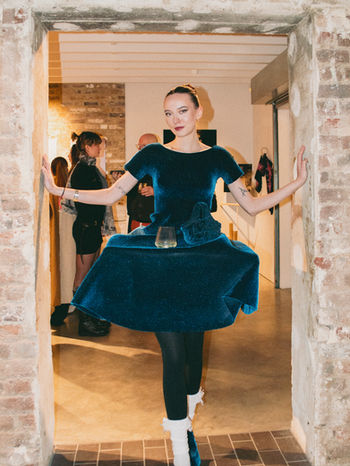











The Diamond Babydoll is a dress whose creation spanned four years. It comprises eighteen printed pattern pieces which took four hundred hours to produce. Walsh has painstakingly joined these pieces together and hand applied over thirty thousand Swarovski crystals to finish. This extreme commitment to intricate craftsmanship has not just informed its material construction, but the conceptual foundation of Walsh’s work. The notion of fusing statues and garments is at the heart of Walsh’s most recent design. Both static and timeless, the idea of a statue is starkly anti-fashion. Using the idea of dolls and showgirls as the aesthetic foundation of this work, Walsh confronts ideas around the relationship between fashion and the body, the significance of movement, display and ornamentation. It is a visual language of simplicity, nostalgia, and costume which support an antifashion sentiment. The babydoll dress as a style is simple and modest - its original purpose was as casual nightwear. What is significant here is that rather than pillage the past for inspiration, Walsh protects the past and presents this silhouette in its original form. Instead of seeking the past as a toy to be played with, this work brings it forward and puts it on a pedestal, as a monument against change. The Diamond Babydoll is heavily inspired by glamorous underground nightlife figures and their aspirational artifice. The dress stands in for a certain self-proclaimed fame, belonging to a cast of people who understand not just self promotion but self construction. Simone de Beauvoir’s writing on the bondage of elegance is useful here in drawing out the symbolic significance of femininity. Relating ornamentation to display, she writes “to care for her beauty, to dress up, is a kind of work that enables the woman to take possession of her person ... her ego seems chosen and recreated by herself”, “once she is dressed, the woman does not present herself to observation, she is like a picture or statue, or the actor on stage. It is this identification with something unreal, fixed, perfect”. This is a complete subversion of typical conceptions of how fashion relates to the body. The body is a part of dress, not simply a canvas for clothing. The body’s pose, gesture, and articulation are all impacted by the clothes one is wearing. Fashion is an embodied practice, where it is the process of wearing clothes, not the static worn that creates meaning. Consider the ghostly feeling of a museum filled with clothes worn only by mannequins; they are lifeless and incomplete. The Diamond Babydoll as a static sculpture completely uproots these ideas. The fact that it is unmoving means that it does not respond to the movements of the wearer, and as such do not represent the significance of their pose or gesture. similarly, it would look the same on any wearer. Thus despite how form fitting and free flowing it may have been designed to appear, it obscures rather than reveals the body. This is a reversal of the typical dress/body relationship. In this instance, clothing precedes the wearer in its significance; instead of a fake body wearing ‘real’ clothes, we have real bodies wearing ‘fake’ clothes. This subversion breaks down understanding of traditional theories of dress, diverging from and reinventing what we see as the fundamental role of clothes as they relate to the body and the self. There is an illusion of movement in a garment which is completely static. Even the materials; what appears to be modelled after something old is actually the result of sophisticated 3D printing of recycled materials. The Diamond Babydoll uses simple and familiar language to present something completely new, contending with fundamental theories of what fashion is and how it works. Dealing simultaneously with tenets of expression and change, the relationship between self and society, Walsh has presented an innovative vision brought to life with similarly innovative technique. Using the language of old, common, and familiar the Diamond Babydoll communicates something new, original, and exciting. Words by Louis Thompson.









































